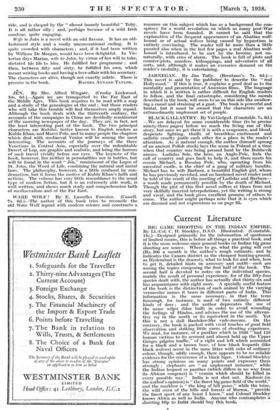Current Literature BIG GAME SHOOTING IN THE INDIAN EMPIRE. By
Lt.-Col. C. H. Stockley, D.S.O. Illustrated. (Constable. 18s.)—Designed primarily for the information of sportsmen of limited means, this is before all things a practical book, and it is the more welcome since general books on Indian big game shooting are scarce. Where to go, what the going will cost (Rs. 500 a month is the author's rough estimate, and he indicates the Canara district as the cheapest hunting-ground, as Hyderabad is the dearest), what to look for and when, how to get it, detailed hints on armoury and outfit—such are among the topics composing the first half of the book." The second half is devoted to notes on the individual species, mainly the result of personal experience, for of the fifty-four species dealt with, the author has actually shot thirty-six and has acquaintance with eight more. A specially useful feature of the book is the distinction of each animal by the varying vernacular names it bears in different parts of India. This information is the more necessary, in that the term barasingh, for instance, is used of two entirely different kinds of deer ; and the author deprecates the use of the name nilgai (blue bull) in order to avoid wounding the' feelings of Hindus, and advises the use of the alterna- tive roj in the north or its equivalent in the south. Yet this is not a dull Baedeker-like vade-mecum. On the contrary, the book is packed with vivid touches of good field observation and striking little yarns of shooting experience. We read, Tor instance, of a panther which in 1926 " had -125 human victims to its account and almost held up the Upper Ganges pilgrim traffic," of a right and left which accounted for- a black and a brown bear, of how black leopards (like black wolves) occur in the same litter with cubs of ordinary colour, though, oddly enough, there appears to be no reliable evidence for the occurrence of a black tiger. Colonel Stoeldey has" strong opinions on many points and expresses them strongly ; elephants are " an unpleasant nuisance," while the Indian leopard or panther (which differs in no way from its African congener) is " vermin which should be killed in every possible way. India is not shot out. Kashmir. (in the author's opinion) is " the finest big game field of the world," and the markhor is " the king of hill game," while the tsine, the wild oxen of the hills and forests of Burma, " provide the finest sport of any beast I know," and Colonel Stockley knows Africa as well as India. Anyone who contemplates a shodthi,g trip '51 Indhrshotkilmiy this book. ' - • - -






























































 Previous page
Previous page